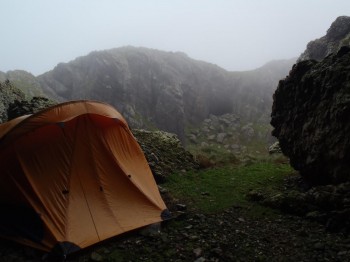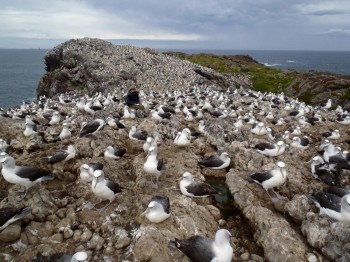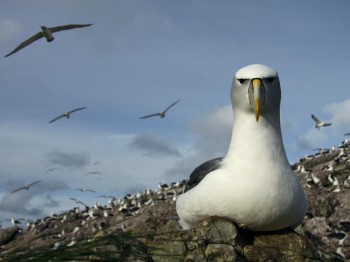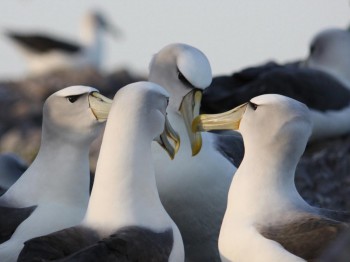
Access to Albatross Island is a 35-km boat ride across the confused, and often treacherous, waters of the Bass Strait from northern Tasmania. The island is one of only three breeding localities for Australia’s endemic and Vulnerable Shy Albatross Thalassarche cauta. The 18-ha island is a Tasmanian State Nature Reserve and part of an Important Bird Area. Currently no public access is allowed to the Albatross Island Nature Reserve to protect the breeding environment of the Shy Albatross.

A large cave system runs much of the length of Albatross Island and provides some protection from the elements for researchers.

The largest colony on Albatross Island, unimaginatively named “Main Colony”, contains over 3000 breeding pairs of Shy Albatrosses each year.

The steely stare of a Shy Albatross. Exploited for its feathers to near extinction in the 1800s, the population on Albatross Island has gradually recovered from as few as two or three hundred to the current 5200 breeding pairs. The island is also a breeding site for Short-tailed Shearwaters Puffinus tenuirostris and Fairy Prions Pachyptila turtur, among several other seabird species.

Photographs by Rachael Alderman and Kris Carlyon
Four young Shy Albatrosses practice their courtship routines on one another. Shy Albatrosses return to their colony as young as three years of age, but typically do not commence breeding until at least seven or eight years old.
Selected References:
Alderman, R.L. 2012. The Shy Albatross (Thalassarche cauta): Population Trends, Environmental and Anthropogenic Drivers, and the Future for Management and Conservation. PhD thesis, University of Tasmania. 180 pp.
Alderman, R., Gales, R., Hobday, A. J. & Candy, S. 2010. Post-fledging survival and dispersal of shy albatrosses from three breeding colonies in Tasmania. Marine Ecology Progress Series 405: 271-285.
Alderman, R., Gales, R., Tuck, G.N. Lebreton, J.D. 2011. Global population status of shy albatross and an assessment of colony-specific trends and drivers. Wildlife Research 38: 672-686.
Anon 2000. Small Bass Strait Island Reserves Draft Management Plan October 2000. Low Islets Nature Reserve Moriarty Rocks Nature Reserve Foster Islands Nature Reserve Tenth Island Nature Reserve Judgement Rocks Nature Reserve West Moncoeur Island Nature Reserve Rodondo Island Nature Reserve Reid Rocks Nature Reserve Black Pyramid Rock Nature Reserve Albatross Island Nature Reserve Penguin Islet Nature Reserve Cat Island Conservation Area. Hobart: Parks and Wildlife Service, Department of Primary Industries, Water and Environment. 33 pp. + 14 maps.
Baker, G.B., Double, M.C., Gales, R., Tuck, G.N., Abbott, C.L., Ryan, P.G., Petersen, S.L., Robertson C.R. & Alderman, R. 2007. A global assessment of the impact of fisheries-related mortality on shy and white-capped albatrosses: conservation implications. Biological Conservation 137: 319-333.
Brothers, N., Pemberton, D., Pryor, H. & Halley V. 2001. Tasmania’s Offshore Islands: Seabirds and other Natural Features. Hobart: Tasmanian Museum and Art Gallery. 641 pp.
Hedd, A. and R. Gales. 2001. The diet of Shy Albatrosses Thalassarche cauta at Albatross Island, Tasmania. Journal of Zoology 253: 69-90.
Hedd. A. & Gales, R. 2005. Breeding and overwintering ecology of Shy Albatrosses in southern Australia: year-round patterns of colony attendance and foraging-trip durations. The Condor 107:375-387.
Rachael Alderman, Biodiversity Conservation Branch, Department of Primary Industries, Parks, Water & Environment & John Cooper, ACAP Information Officer, 29 March 2013

 English
English  Français
Français  Español
Español